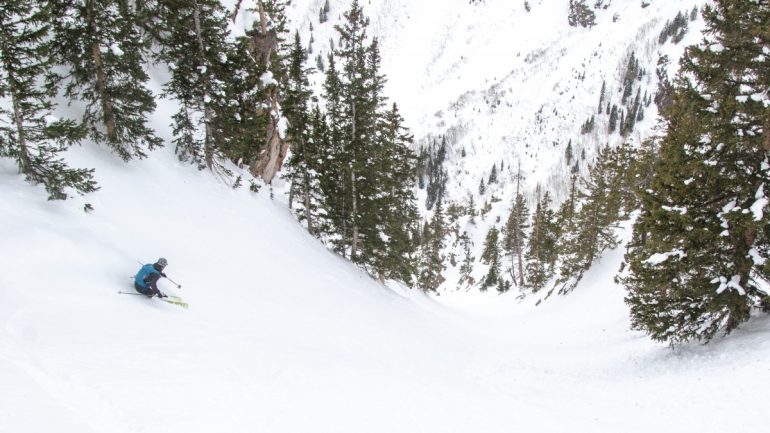
Fellow WildSnow contributor Slator Alpin skis the BD Helio Binding in a steep and icy chute in the Gore Range.
There I was, perched at the top of a committing line deep in the Gore Range, my sole focus on navigating a tight choke before the couloir opened up above a rock band. I side slipped down the slope, my skis chattering against the bulletproof windboard when I heard a mysterious pop and felt my heel slip sideways. I quickly caught myself on my downhill ski and looked at my uphill boot. The heel turret on my binding had exploded. The plastic casing lay open like a clamshell and the interior pieces sat ajar, doing nothing to lock in my boot to my ski.
I snatched up the dangling pins before they careened down the steep couloir and then sank my ice tool into the firm snow. I pulled off my right ski and got to work with a handful of Voile straps. Three well-placed straps later I had relative peace of mind that the jerry-rig should hold long enough to get me through a couple of jump turns.
The moral to that story: I no longer opt for plastic in my tech bindings. At least in steep and consequential terrain. The simpler the better.
The Black Diamond Helio 145 is a rebranded binding from the Italian ATK Trofeo that fits neatly into this category of lightweight bindings that are a half-step above a full randonee race binding. And yes, there’s no plastic. ATK’s reputation for making durable, lightweight, and innovative bindings arrives overseas through Black Diamond’s distribution network.
Construction
The binding construction is a testament to the skill of ATK’s engineers when it comes to low-tolerance CNC machining work. A combination of alloy metals and stainless steel, this binding tops the charts in build quality and long-term durability. Even though the Helio 145 was first introduced under the Black Diamond brand in 2019, it comes from ATK’s strong reputation for high quality and durable construction.
At 145 grams the Black Diamond Helio 145 sits very comfortably on the light end of the binding spectrum. In this category of binding, we are dealing with something that is a half-step above the purely racing binding and something that is at home on long days in the mountains.
Toe Piece
The feature that sets this binding apart from the rest is the unique use of a single spring in the toe piece that is dubbed by ATK as “Monolink Technology”. Where in other bindings you will find two springs, one for each side of the binding arm, you will only find one spring and the other arm is rigid. This design decision does two things. First, it reduces the weight of the binding by simplifying the system, and second, it increases the torsional rigidity of the toe-piece.
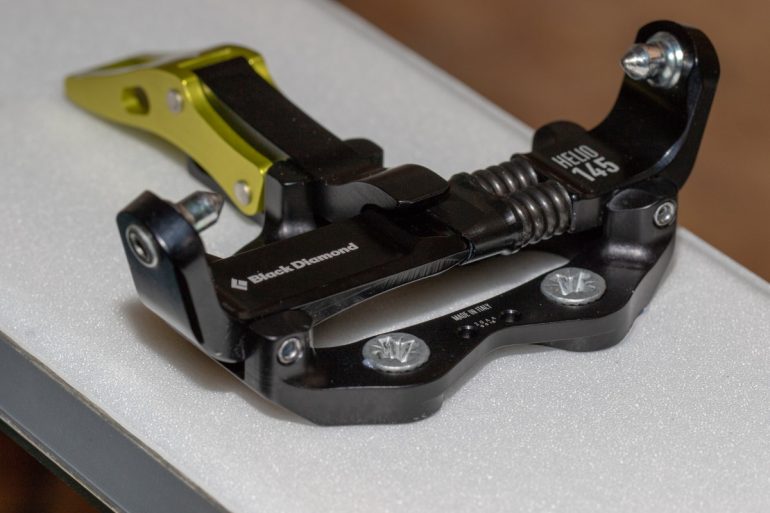
Close up view of this minimalist toe piece featuring the monolink technology. A fixed arm on one side and a single spring on the other.
The first impression of stepping into these toe pieces is that the mechanical action is very smooth. The construction of this binding is very precise. The single spring provides a satisfying pop in engaging the binding arms.
After putting some mileage into these toe pieces the benefits of the Monolink technology become apparent. The torsional rigidity of this minimalist toe piece is impressive, these bindings can be skied very hard without the toes locked.
Looking at the smaller details, the toe locking mechanism is smooth, sturdy, and certainly near the top of the pin binding class. The toe-piece uses a roller bearing for a satisfying locking operation. Another under-appreciated feature in pin bindings is that the lock-out lever is very easy to use. A common misstep in lightweight pin bindings of this category puts a small, plastic lever that sits near-flush with the ski. Not only have these plastic levers broken on me in the past, but also they are just a tiny bit annoying to pull up on to lock out the toe. The Black Diamond Helio 145 features a metal lock-out lever with a good purchase to lock off the toe.
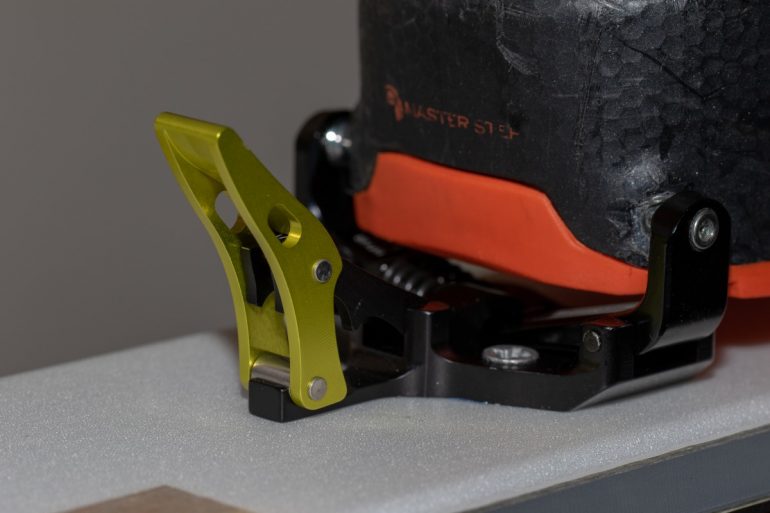
A close look at the toe piece of the Black Diamond Helio 145 binding. Fully locked out, the smooth action of the lever is achieved through a rolling cylinder that snugly locks into place.
The next feature I want to highlight seems insignificant and perhaps a little exacting and fastidious. A common feature in modern pin bindings is this little groove machined out of the toe pin called an “auger”. For myself, this is a very welcomed feature in other bindings that is notably missing from the Black Diamond Helio line.
Why is a pin auger important? It maintains binding performance in the field. As you rock your boot back and forth on the binding, this auger will dig snow and ice out of your boot’s tech insert. Walking and climbing in snow will cause snow and ice to buildup inside of the small inserts in your toe. Snow and ice build-up inside of your tech insert will negate the effectiveness of the binding by preventing the pin to fully slide into the insert. In the field, this can easily lead to your boot unexpectedly popping out of the toe piece. This is a critical feature if you are using the binding for a ski mountaineering purpose because it is a feature that lends to reliability and dependability in consequential terrain.
Another notable omission for a pin binding in this category is the fact that the crampon slot is missing. This attachment can be purchased separately but it is disappointing that a binding marketed for ski-mountaineering is missing a feature that allows the use of ski crampons.
Heel Piece
The BD Helio 145 features a simple race-style heel piece. The attraction here is that this type of minimalist binding is very reliable. With fewer moving parts, simple components in construction, there are fewer critical points of failure. I don’t expect this heel piece to blow up on me as others have in the past.
By choosing this style of binding you are making an intentional choice to forgo more sophisticated binding designs that values dynamic heel release. It is important to note that this is not a “fixed” heel as you would find in many race bindings. The heel turret rotates, offering a lateral rotation which also plays a role in release. In this binding, you will find an interchangeable u-spring that you will choose when buying. Three options are available to you (6, 8, 10 release values) and you will be forced to commit to your release value at the time of purchase. With that trade-off, you get reliability in heel retention.
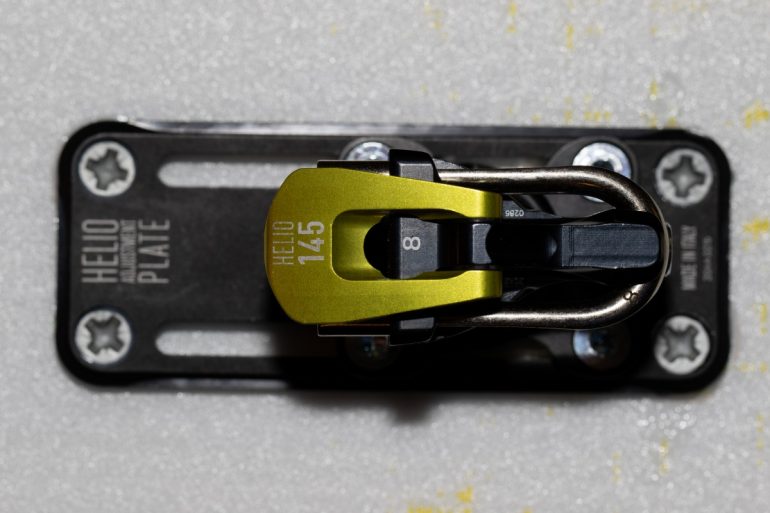
This binding does not feature an adjustable DIN setting, instead you can order this binding with one of three DIN options (pictured is DIN 8) determined by the stiffness of the U-Spring.
There are three walking modes: A flat mode (+0 mm), a pin flap that prevents your boot from clicking in (+37 mm), and a small riser option (+45 mm) by turning the heel 180°. This third mode does not offer much of a difference from the second heel riser options so I did not find myself using it very much. Other bindings in the market offer a substantial third heel rise between +45mm to +90mm that you won’t find with the BD Helio 145. Worth noting if you like higher risers.
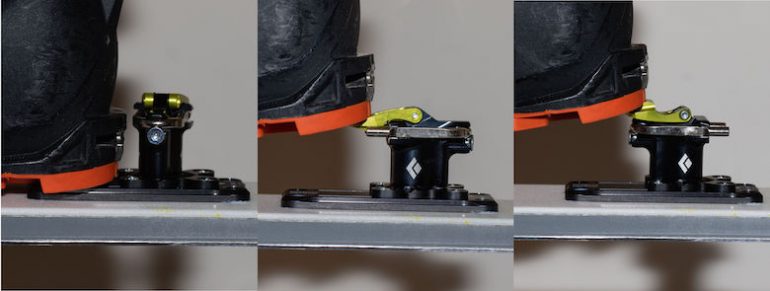
Side by side comparison of the three riser settings. Flat Riser (+0mm) Second heel riser (+37mm) and Third heel riser (+45mm)
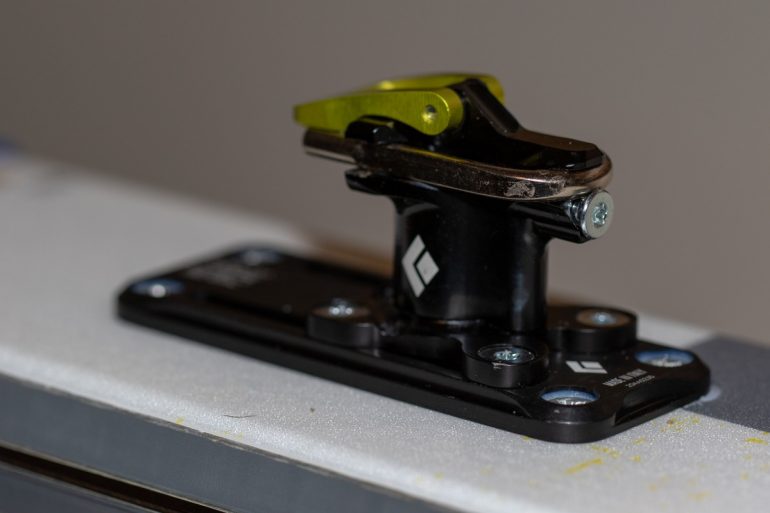
The minimalist heel piece of the Black Diamond Helio 145. I mounted this binding with an adjustment plate (sold separately) adding a 60 gram weight penalty and 30 mm of adjustability.
In terms of adjustment, this is a fixed adjustment binding, meaning that it cannot be changed to accommodate different boot sizes without remounting. I chose to include an adjustment plate when mounting up these bindings. The separately purchased plate offers 30mm of adjustment at the cost of 60g of additional weight.
How do they ski?
As expected, the uphill is dreamy with these bindings. Pair them with a lightweight ski and you will be flying up the skin track. The ease and simplicity of use make transitions very easy and fast. Just flip the heel flap back and click in. These are bindings designed for fast uphill travel and they live up to that description.
The BD Helio 145 bindings ski as would be expected. They are simple in nature and securely affix your boots to your skis. You won’t get the elasticity and play that you would expect from a fully-featured binding but the fact that your feet are firmly attached to the ski lends well to responsiveness.
A symptom of this race-style of binding is that they take some time to get used to and are not forgiving. After a few seasons on race bindings, I find that I am able to maintain my hard-charging and directional skiing style. I can still arc turns on hardpack and ski dynamically in powder but there was a learning curve. For such a small package I feel comfortable skiing hard on them which is something I cannot say for other bindings in this class.
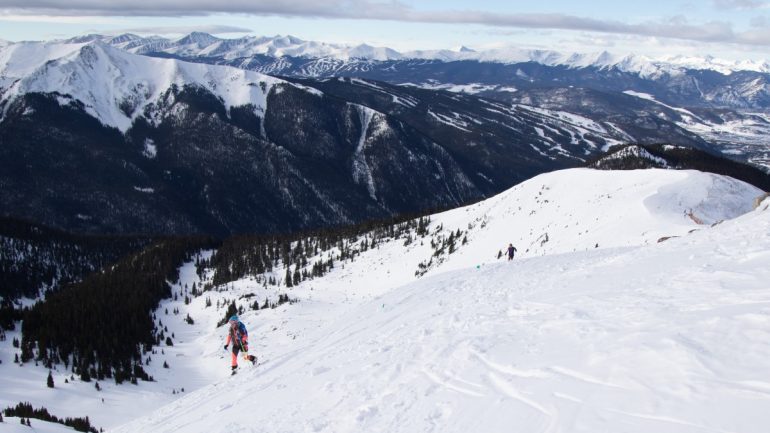
Best paired with a lightweight pair of skis, this binding can handle a wide range of backcountry ski applications. This binding feels at home in a ski-mountaineering race (pictured) as well as a long backcountry day in a variety of conditions.
Not only will this binding do well in a skimo racing context, but I also see this binding for someone putting together a dedicated lightweight backcountry skiing kit. Put this on a mid-waisted and versatile ski and you will be very happy. Such a big portion of your ski tour is spent going uphill that a binding that will make the uphill easier is a significant consideration.
The Final Word
The rebranding of ATK’s iconic Trofeo binding is a welcome sight on North American shelves. For a binding that is so minimalist and simple, the small details become increasingly important. The Black Diamond Helio 145 is an almost-perfect binding in its class of lightweight and minimalist race-style bindings. This style of tech binding is not for everyone but finds a perfect home in the realm of ski-mountaineering and big days in the backcountry. This binding is a reliable option for the wear and tear of backcountry skiing and dependable on steep and consequential terrain.
SPECS
Weight: 145 g / 5.1 oz
Weight per pair: 290 g / 10.2 oz
Materials: Alu Alloys, Stainless Steel, POM
Release value: Fixed 6, 8, 10
Adjustment: Optional Plates
Shop for the Black Diamond Helio 145
Testing Conditions
Testing location: Aspen and Marble, Colorado
Snow Conditions: Powder, Piste, Variable Crud, Steep and Icy Chutes.
Skier Height/Weight: 5’11 – 150 lbs
Ski: WNDR Vital 100
Ski Boots: Atomic Backland Carbon and Dynafit Hoji Pro Tour
Aidan Goldie is a ski mountaineer and avalanche professional based out of Colorado. When he is not climbing and descending peaks in the American West, he is an educator, working with schools and nonprofits guiding groups through the Colorado wilderness. Follow his work in developing a more equitable mountain ethic: @aidan.goldie

Aidan Goldie is a Basalt-based backcountry skier and photographer. When he is not climbing and descending peaks in the American West, he is an outdoor educator, working with schools and nonprofits guiding groups through the Colorado wilderness.
